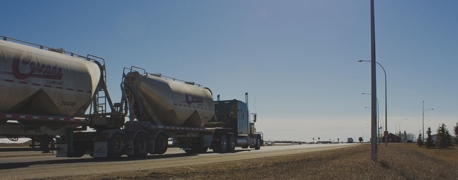Flashing Amber Lights on Tractor-Trailers: Bending the Rules to Prevent Rear-End Crashes

Rear-end accidents involving large trucks are not only one of the most common types of traffic collisions, but they are also often the most likely to cause catastrophic injury or death.
A smaller vehicle, if it rear-ends a truck, will sustain damage at the front of the vehicle and may “underride” or go underneath the trailer. Even if the driver directly behind a semi manages to stop in time, the driver behind them may still rear-end and push their vehicle into the truck’s trailer. This puts the occupants of the smaller vehicle at risk of experiencing extreme injuries.
Why do these accidents happen? Most rear-end crashes can be attributed to bad habits like following too closely, but distracted driving is a leading culprit as well. A distracted driver will not notice traffic slowing or even stopping ahead until it’s too late. They may not see the brake lights of the vehicle in front of them, even when that vehicle is an 80,000-pound semi-truck.
Distracted driving is responsible for about one-third of traffic fatalities in the U.S. each year, and when a distracted driver runs into the back of a truck, the worst injuries can occur.
Trucks have long been retrofitted with brake lights and reflective tape on their trailers to improve visibility and inform drivers that they are applying their brakes, but one trucking company saw room for improvement. However, it took bending the rules to achieve the desired result.
Groendyke Goes Rogue & Installs Amber Lights on Their Tanker Trucks
Since 1932, tanker truck carrier Groendyke Transport has placed an unparalleled emphasis on safety. The company has long been known for its safety record and focus on accident prevention, and it is the only eight-time winner of the National Tank Truck Carriers North American Safety Champion award.
In 2014, Groendyke decided to take its commitment to safety even further. Like other carriers, it faced the devastating results of distracted driving, particularly with other motorists rear-ending their tankers. But, it saw this as a problem that could be approached in a new and different way: by grabbing the attention of distracted motorists before they could hit the company’s trucks.
The only problem? The Federal Motor Carrier Safety Administration (FMCSA) had set rules on braking systems and lights for tractor-trailers. 49 CFR § 393.25(e) prohibited the use of anything other than a steady burning red light as the brake light for trucks.
Groendyke needed to think outside the box to create a better way to alert distracted motorists.
The idea of using amber lights came from the warning lights that advance certain traffic signals at rural intersections. If such a light flashed briefly when the truck driver applied the brakes, it should be enough to get a motorist’s attention. The light would need to be bright enough to be seen during the day or at night, and even in heavy weather. Placement would also be important, so it could be seen not only by the driver immediately behind the truck but also by any drivers beyond.
Groendyke began ordering its trailers with high-mounted brake lights (located about nine feet high in the center of the back of the trailer) and replacing the standard red light with a flashing amber one.
The company tested the new flashing amber lights at its terminal in Enid, Oklahoma before pushing them out to its locations in Kansas City, Denver, and Fort Worth. Right away, Groendyke’s drivers started reporting improved driving behavior from the motorists following behind their trailers. Unfortunately, some drivers also began receiving tickets for the technically illegal amber lights, to the tune of about 40 or 50 violations. All were issued in two states and one scale house issued most of the tickets.
Still, Groendyke persisted. Over the course of 2 years and 90 million miles traveled, Groendyke tracked rear-end collisions involving its tanker trucks retrofitted with the flashing amber lights versus those that had standard brake lights.
The results? A nearly 34% reduction in rear-end accidents involving trucks with flashing amber lights.
In April 2018, Groendyke used the data from its unsanctioned experiment to submit a formal petition to the FMCSA for an exemption from 49 CFR § 393.25(e). The FMCSA approved it in April 2019. Now, tanker trucks can be fitted with pulsating amber brake lights. The exemption went into effect on October 8, 2020, and will last for 5 years until October 8, 2025.
Taking It a Step Further: Grote Industries’ Amber Lights for All Tractor-Trailers
Groendyke’s bold move paid off in the form of an exemption to the FMCSA standard for steady-burning brake lights, but that only applied to tanker trucks. It took another petition, this time by a brake light manufacturer, to get an exception that would apply to other large trucks.
On December 7, 2020, the FMCSA granted an exemption after Grote Industries petitioned for motor carriers with trailers and van body trucks to install “amber brake-activated pulsating warning lamps.” The limited five-year exemption allows these amber lights to be installed in addition to standard brake lamps. It went into effect on December 7, 2020, and will last until December 2, 2025.
The flashing amber light designed by Grote Industries is made as an add-on warning light that can be wired into the truck’s brake circuit. When the truck driver brakes, the light flashes amber five times within four seconds and then turns to a solid red. The five-flash sequence was designed to get a driver’s attention without causing too much distraction by continuing to strobe.
The Future of Amber Lights for Tractor-Trailers
The FMCSA exemptions that allow flashing amber lights for tanker trucks and tractor-trailers may be temporary, but the goal is for a permanent exception that will allow for continued improvements in roadway safety. We all must share the road, and any steps that help prevent rear-end collisions are in the best interests not only of the motorists who may be severely injured in these crashes, but also of truck drivers and carriers as well.
- Categories


